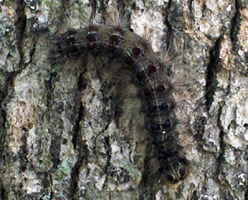NJDA SURVEYS SHOW GYPSY MOTH POPULATIONS REMAIN AT LOW LEVELS
498-Acre Spray Program Proposed
For Immediate Release: January 7, 2015
Contact: Lynne Richmond
(609) 633-2954
lynne.richmond@ag.state.nj.us
(TRENTON) – New Jersey Department of Agriculture surveys of 22 New Jersey municipalities have found areas in four towns in three counties that qualify for the state’s 2015 Aerial Gypsy Moth Suppression Program.
The Department today proposed spraying a total of 498 acres in Morris, Passaic and Hunterdon counties.
“This year’s spray program is part of our continued surveillance designed to keep gypsy moth populations low, preventing a nuisance to homeowners and protecting trees,” said New Jersey Secretary of Agriculture Douglas H. Fisher. “We know from the past how quickly populations can expand given the right conditions. We need to keep up our intense monitoring to suppress these tree-killing insects.”
Gypsy moth egg mass surveys were conducted from August to December in the 22 municipalities and agencies that requested them. From these surveys, it was determined that 288 acres in Morris County, including two residential areas and 114 acres in Mahlon Dickerson Reservation in Jefferson Township, and 40 acres in Silas Condict Park in Kinnelon Borough in Morris County had high enough gypsy moth populations to qualify for the Department’s 2015 spray program. In addition, 123 acres in West Milford in Passaic County and 87 acres in Lebanon Township in Hunterdon County were identified as qualifying for the spray program. Participation in the program is voluntary. If the towns agree, spraying would take place in late May and June.
To qualify for the spray program, a residential or recreational forest must have an average of more than 500 egg masses per acre and be at least 50 acres in size. A single egg mass contains up to 1,000 eggs.
Because of recent decreased gypsy moth populations, there has been no spray program since 2011, when just 274 acres were treated in Waterford and Winslow Townships in Camden County.
In last summer’s aerial defoliation survey, West Milford had 267 acres of trees defoliated, Kinnelon had 118 acres, and Lebanon Township had 18 acres. Statewide last year, there were 1,330 acres of trees stripped of their leaves by gypsy moth caterpillars in 24 towns in 11 counties.
Two to three consecutive years of significant defoliation (defined as 75 percent or more) can kill an otherwise healthy tree. However, any gypsy moth defoliation can make trees more susceptible to other damage that can lead to the death of the tree. Oak trees are the preferred host for gypsy moths, but the caterpillars can be found feeding on almost any tree in the vicinity.
For more information on New Jersey’s gypsy moth suppression program, visit: www.nj.gov/agriculture/divisions/pi/prog/gypsymoth.html. Also, for national gypsy moth material, visit www.na.fs.fed.us/fhp/gm/.



